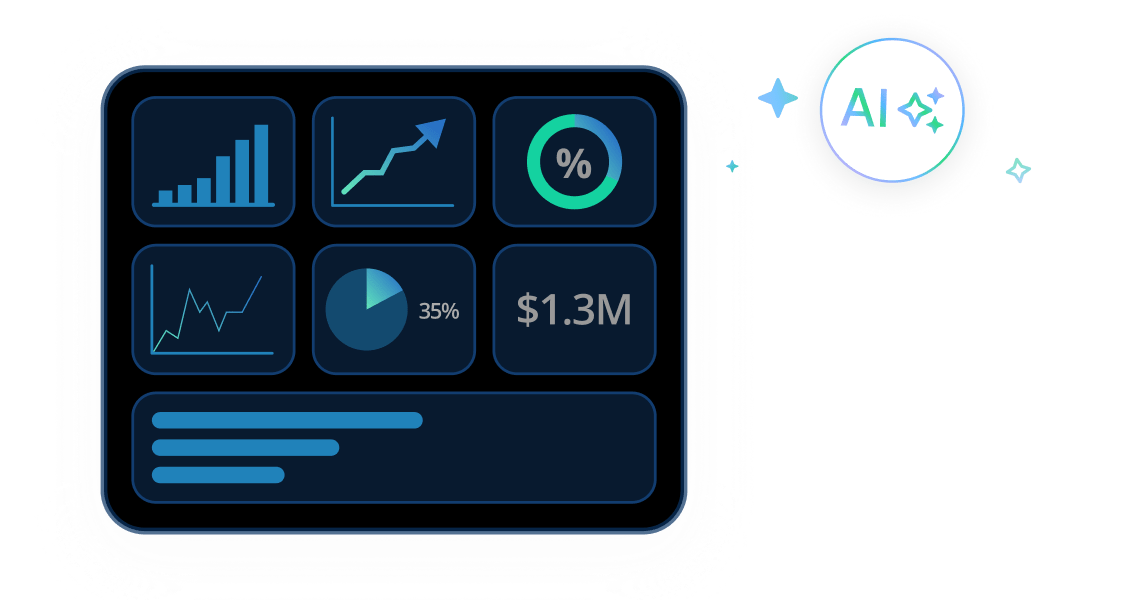Key Takeaways
|
|
|
|
If you have ever stared at a packed dashboard and wondered which number actually matters, you are not alone. Sales leaders track dozens of metrics each week, but the hard part is figuring out which ones point to meaningful growth. When everything feels equally urgent, it becomes harder to spot patterns and act with the kind of clarity your team needs.
To achieve stronger returns from your tools, team, and sales process, focus on sales KPIs that reveal the most reliable indicators of performance. This includes familiar metrics like lead conversion rate as well as long-term drivers like customer and employee retention.
This guide walks you through the most critical sales KPIs to watch in 2025, so your team will sell smarter and grow faster with data that’s proven to move your business forward.
What are Sales KPIs?
Sales KPIs transform raw numbers into meaningful business metrics that track how individuals, departments, or companies perform against their targets and goals. These indicators cover financial performance, deal progress, and team or individual contributions.
By focusing on these metrics, organizations can measure the effectiveness of sales campaigns, strengthen sales training programs, and make data-driven decisions that consistently improve sales performance while increasing long-term revenue growth and stability.
Read eBook: Digital Selling Guide to Win More Deals
Key Sales KPIs for Sales Leaders to Watch in 2025
Most sales teams still track KPIs like the number of leads, deals closed, or how individuals are doing on quota. Those numbers do have value, but they often tell a one-off story that doesn’t help you plan for sustainable growth or repeatable results.
If you want your revenue to be predictable and your strategy to stay useful, you need to monitor both traditional performance metrics and the ones that reflect longer-term value from customer and employee relationships.
Here’s a closer look at the most critical B2B sales KPIs you should monitor in 2025.
1. Monthly sales growth
No business wants to stay stuck at one level for long, and sales growth gives you an immediate signal when something’s slowing down. By tracking monthly sales growth, leaders can spot trends early and act before minor issues become major problems.
Once you’ve set clear monthly sales targets, you can keep the team focused and motivated with numbers they understand and can influence.
Here’s how to calculate it:
Monthly Sales Growth = ((Current month’s sales – Previous month’s sales) / Previous month’s sales) x 100
2. Average profit margin
Revenue means little if profits are weak, which is why average profit margin remains one of the most important sales KPIs. It calculates the profit your company makes by subtracting the costs of goods or services from sales revenue.
Leaders can also review profit margins by territory, product line, or even individual reps to spot problem areas. For businesses with broad product ranges or flexible pricing, monitoring profit margin regularly prevents small gaps from becoming larger issues.
The formula is:
Average Profit Margin = (Net income ÷ net sales) x 100.
3. Monthly sales bookings
This metric tracks the total value of signed or committed deals within a specific month. B2B companies, especially SaaS businesses, often rely on this number to guide forecasting and strategy. Because it includes signed deals, not just pipeline estimates, it gives a more accurate view of booked revenue compared to expected revenue.
The formula is:
Monthly Sales Bookings = Total new booking value – (Average cost per transaction x Total bookings)
Suggested read: Why Reps Miss Quota: 3 Stats You Can’t Ignore (And How to Fix Them)
4. Sales opportunities
Sales opportunity value is based on how far along a deal is in your pipeline and how likely it is to close. Your sales process probably includes different stages like qualified, proposal, and negotiation.
Each one gets a weighted value that reflects how close it is to the finish line. Tracking this metric gives sales leaders a better read on potential revenue and helps teams decide where to focus.
Here’s how to calculate it:
Sales Opportunity = Estimated sale value x Opportunity status weight
For example, a $10,000 deal in negotiation at a 0.5 weight means a $5,000 opportunity value.
5. Sales target attainment
This one answers questions most leaders ask every month, including:
- Are we going to hit the number?
- Who’s behind and needs help?
- Who’s ahead and can share what’s working?
By comparing actual sales to set targets, you get a running read on performance without waiting until the end of the quarter. Use this KPI in a leaderboard or dashboard so everyone can see how the team is doing in real time.
The formula is straightforward:
Sales Target Attainment = (Sales this period / Sales target) x 100
6. Quote-to-close ratio
The quote-to-close ratio measures how many sent quotes actually convert into closed deals, giving leaders a clear view of sales effectiveness. Comparing current ratios to historical benchmarks helps identify whether messaging, pricing, or sales processes require improvement.
For example, if a rep sends 100 quotes and closes 30 deals, the ratio is 30%. Because this KPI highlights conversion strength, it is one of the most practical sales KPI examples for evaluating individual rep performance.
Here’s how you can calculate it:
Quote-to-Close Ratio = (Closed and won deals / Total quotes sent) x 100
For instance, if a rep sends 100 quotes and closes 30, that’s a 30% quote-to-close ratio.
Related read: How AI Sales Training Improves Ramp Time and Readiness
Track KPIs With an AI Sales Enablement Software
An effective CRM system automates the lead-to-cash cycle and collects data points that matter at every stage of the sales process.
As an AI sales enablement platform, SalesHood brings training, content, coaching, and sales management together in one platform so teams can sell smarter and faster. The platform tracks performance across playbooks, training, and calls without adding extra manual effort. With AI-driven insights, sales leaders understand how content influences outcomes, refine sales content for stronger impact, and engage buyers more effectively.
To highlight how this platform transforms performance, here are specific features that stand out:
- Just-in-time enablement: Equip teams with on-demand coaching, onboarding, and sales training so they ramp quickly and close deals faster.
- Revenue impact: Connect content, plays, and programs directly to sales results and track performance without additional tools.
- AI role play: Provide scenario-based AI simulations so sales reps can practice responses and improve messaging with real-time feedback.
- Digital sales rooms: Create customized buyer spaces that feel personal and help representatives stand out during long sales cycles.
- Impact insights: Measure the effectiveness of training, coaching, sales content, and digital sales rooms to understand how each program drives rep performance, buyer engagement, and revenue growth.
- Sales coaching insights: Give enablement leaders the ability to boost sales productivity and strengthen overall revenue impact with coaching data.
Schedule a demo today and experience how SalesHood helps transform the way revenue teams perform.



